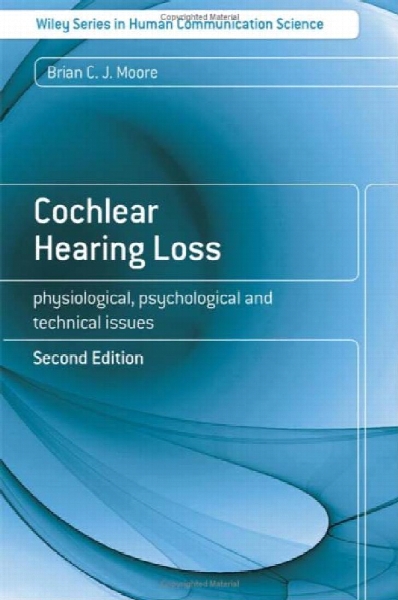Cochlear hearing loss : physiological, psychological and technical issues: 2nd
- نوع فایل : کتاب
- زبان : انگلیسی
- مؤلف : Brian C J Moore
- ناشر : Chichester ; Hoboken, N.J. : John Wiley & Sons,
- چاپ و سال / کشور: 2007
- شابک / ISBN : 9780470518182
Description
1. Physiological aspects of cochlear hearing loss. Linear and nonlinear systems -- Structure and function of the outer and middle ear -- Structure and function of the normal cochlea -- Neural responses in the normal auditory nerve -- Types of hearing loss -- Physiology of the damaged cochlea -- 2. Absolute thresholds. Measures of absolute threshold -- Descriptions of the severity of hearing loss -- Causes of hearing loss due to cochlear damage -- Perceptual consequences of elevated absolute thresholds -- 3. Masking, frequency selectivity and basilar membrane nonlinearity. The measurement of frequency selectivity using masking -- Estimating frequency selectivity from masking experiments -- Characteristics of the auditory filter in normal hearing -- Masking patterns and excitation patterns -- Non-simultaneous masking -- The audibility of partials in complex tones -- Effects of cochlear damage on frequency selectivity in simultaneous masking -- The use of masking to diagnose dead regions -- Effects of cochlear damage on forward masking and suppression -- Effects of cochlear hearing loss on BM input-output functions -- Perceptual consequences of reduced frequency selectivity, dead regions, loss of suppression and steeper BM input-output functions -- 4. Loudness perception and intensity resolution. Loudness perception for normally hearing people -- Effects of cochlear hearing loss on loudness perception -- A model of normal loudness perception -- A model of loudness perception applied to cochlear hearing loss -- Effects of bandwidth on loudness -- Effects of cochlear hearing loss on intensity resolution -- Perceptual consequences of altered loudness perception -- 5. Temporal resolution and temporal integration. Modelling within-channel temporal resolution in normal hearing -- Temporal resolution in normal hearing -- Temporal resolution in people with cochlear damage -- Temporal integration at threshold -- Temporal integration at suprathreshold levels -- Perceptual consequences of abnormal temporal processing in people with cochlear hearing loss -- 6. Pitch perception and frequency discrimination. Theories of pitch perception -- The perception of the pitch of pure tones by normally hearing people -- Frequency discrimination of pure tones by people with cochlear hearing loss -- The perception of pure-tone pitch for frequencies falling in a dead region -- Pitch anomalies in the perception of pure tones -- The pitch perception of complex tones by normally hearing people -- Theories of pitch perception for complex tones -- Pitch perception of complex tones by people with cochlear hearing loss -- Perceptual consequences of altered frequency discrimination and pitch perception -- 7. Spatial hearing and advantages of binaural hearing. The localization of sinusoids -- The localization of complex sounds -- The cone of confusion, head movements, and pinna cues -- General conclusions on sound localization -- The precedence effect -- Binaural masking level differences (MLDs) -- Head-shadow effects -- Release from informational masking -- Diotic advantages -- Perceptual consequences of abnormal binaural and spatial hearing in people with cochlear damage -- 8. Speech perception. The magnitude of the noise problem -- The role of audibility -- Influence of dead regions on speech perception -- Correlation between psychoacoustic abilities and speech perception -- Assessing the effects of frequency selectivity on vowel and consonant perception -- Influence of loss of sensitivity to temporal fine structure -- The use of simulations to assess the importance of psychoacoustic factors in speech perception -- 9. Hearing aids. Linear amplification -- Compression amplification -- Some general problems with hearing aids -- Methods for improving the speech-to-noise ratio -- Transposition aids for severe and profound hearing loss -- Cochlear implants.
Since the first edition was published in 1998, considerable advances have been made in the fields of pitch perception and speech perception. In addition, there have been major changes in the way that hearing aids work, and the features they offer. This bo.


